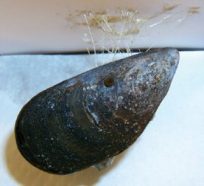Gooey Secrets of Mussel Power
By learning how mussels stick, scientists may find a way to make them come unstuck.
Where do mussels get their muscle? Waves can crash over them, but mussels keep holding tight to shoreline rocks. These tough little mollusks can even cling to the underside of a ship to hitch a ride across the ocean.
 |
|
The common blue mussel makes proteins that allow the organism to cling to just about any surface, including this Teflon sheet. |
| Jonathan Wilker |
A mussel’s grip comes from the glue it makes. Mussel glue is made up of a web of protein molecules. Now, scientists at Purdue University in Indiana have found that the glue also contains lots of iron. This iron might help explain why mussel glue is so strong.
Jonathan Wilker and his coworkers gathered hundreds of mussels from the Atlantic Ocean off the coast of Maine. Back at their laboratory, the scientists placed the mussels on large sheets of glass in tanks filled with seawater. After the mussels attached themselves to the glass, the scientists cut the mussels loose and gathered some of the glue that was left behind.
When chemical tests showed that there’s lots of iron in the glue, the scientists decided to figure out what the iron was for. They first extracted some glue-type proteins from the mussels themselves to make a protein solution. Then they added iron to this solution.
Adding the iron caused the proteins to knit together tightly. This suggests that iron acts like a binding agent in mussel glue, giving the glue its strength, Wilker says.
If scientists can understand better what makes mussel glue stick, they can figure out ways to stop it from working. This would be good news for ship owners, who spend billions of dollars each year scraping the unwanted cargo of mussels and other organisms off their ships’ hulls.
Wilker and his colleagues want to develop a nontoxic, anti-mussel paint for ships. If the scientists are successful, mussels would have to say goodbye to their free rides around the world.—S. McDonagh
Going Deeper:
Goho, Alexandra. 2004. Marine superglue: Mussels get stickiness from iron in seawater. Science News 165(Jan. 17):36-37. Available at http://www.sciencenews.org/20040117/fob4.asp .
Sohn, Emily. 2003. How a gecko defies gravity. Science News for Kids (Nov. 19). Available at http://www.sciencenewsforkids.org/articles/20031119/Feature1.asp .
______. 2003. Worm jaws have metal power. Science News for Kids (Aug. 6). Available at http://www.sciencenewsforkids.org/articles/20030806/Note2.asp .
______. 2003. Butterfly wings and waterproof coats. Science News for Kids (March 5). Available at
http://www.sciencenewsforkids.org/articles/20030305/Note2.asp .
You can learn more about mussels and their stickiness at www.chemistry.org/portal/a/c/s/1/wondernetdisplay.html?
DOC=wondernet%5Cwhatsup%5Csticks%5Cwu_sticky01.html (American Chemical Society).







